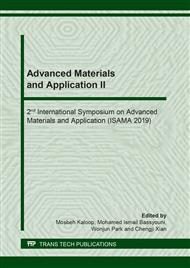[1]
T. Haga, K. Akitsu, T. Yamabayashi, S. Kumai, H. Watari, Strip casting by a single roll caster equipped with a scraper, Key Eng. Mater. 443 (2010) 122-127.
DOI: 10.4028/www.scientific.net/kem.443.122
Google Scholar
[2]
T. Haga, K. Akitsu, S. Kumai, H. Watari, A single roll caster for aluminum alloy strip, Adv. Mater. Res. 382 (2012) 368-371.
DOI: 10.4028/www.scientific.net/amr.382.368
Google Scholar
[3]
T. Haga, K. Akitsu, K. Kamakura, S. Kumai, H. Watari, Single roll caster equipped with a scraper, Key Eng, Mater. 504-506 (2012) 1243-1248.
DOI: 10.4028/www.scientific.net/kem.504-506.1243
Google Scholar
[4]
T. Haga, Y. Shiotsu, K. Komeda, S. Kumai, H. Watari, Improvement of porosity of strip using a scraper on the casting by a vertical type high speed roll caster, Adv. Mater. Res. 146-147 (2011) 1108-1113.
DOI: 10.4028/www.scientific.net/amr.146-147.1108
Google Scholar
[5]
T. Haga, R. Kozono, S. Nishida, H. Watari, Casting of aluminum alloy clad strip by an unequal diameter twin-roll caster equipped with a scraper, Adv. Mater. Proc. Tech. 3 (2017) 511-521.
DOI: 10.1080/2374068x.2017.1344057
Google Scholar
[6]
T. Haga, K. Okamura, S. Nishida, H. Watari, K. Matsuzaki, Casting of an Mg Alloy Clad Strip Using a Twin Roll Caster Equipped with a Scraper, Mater. Sci. Forum. 879 (2017) 671-676.
DOI: 10.4028/www.scientific.net/msf.879.671
Google Scholar
[7]
T. Haga, Effect of the contacting condition between molten metal and roll on Al-12%Si alloy strip cast by melt drag method, The Japan Institute of Light Metals, 48 (1998) 613-617.
DOI: 10.2464/jilm.48.613
Google Scholar
[8]
R. E. Maringer, Solidification on a substrate, Mater. Sci. & Eng. 98 (1988) 13-20.
Google Scholar
[9]
T. A. Gaspar, T. J. Bruce, L. E. Hackman, S. E. Brasmer and J. A. Dantzig, Rapidly solidified titanium alloys by melt overflow, NASA-CR-4253, 1989. (a) Substrate and side dam plates made from 2.3 mm thick mild steel plate (b) Over view of semi-continuous caster.
Google Scholar
[10]
S. Hamer, C. Romanowski, B. Taraglio, Continuous casting and rolling of aluminum: Analysis of capacities, products ranges, and Technology. Light Met Age, 60 (2002) 6-17.
Google Scholar
[11]
P. Y. Menet, R. Cayol, J. Moriceau, Pechiney Jumbo 3CM TM, start-up of the Neu-Brisach thin strip caster, Light Met. (1997)753-756.
Google Scholar


